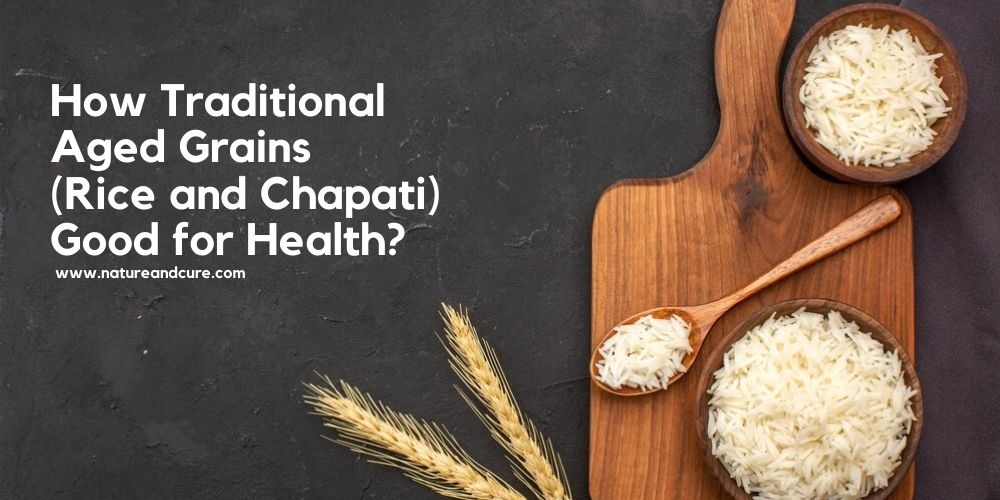
Rice and chapati, a kind of wheat-based unleavened bread, are staple foods that are quite popular in many parts of the world. Even though they are widely consumed, these foods have a high nutritional content and other health advantages that can be further optimized by following practices. One such practice is the aging of wheat and rice, which, despite its strange sound to modern ears, has been carried out for ages in many different countries. You can significantly enhance your health by learning about older grains and including them into your diet. Here’s how.
Grains such as rice and wheat must be developed by keeping them for months or even years in a controlled atmosphere. A number of biochemical changes that affect the grains’ nutritional profiles and increase their digestibility take place during this period. Aged grains are a better option for people who want to maximize their health through diet because of this natural process’s numerous positive impacts.
The lowered glycemic index (GI) of aged rice and wheat is one of their most important advantages. The rate at which food elevates blood sugar levels after consumption is gauged by the glycemic index. High GI foods quickly raise blood sugar and then drop it, which can produce fluctuations in energy and an increase in hunger. Eating aging grains can be quite beneficial for people who have diabetes or are trying to control their blood sugar levels.
Because aged rice and wheat release glucose into the bloodstream more gradually, they offer a more consistent energy source and mitigate the high-GI food-related peaks and troughs. Because of this, they are a great option for providing consistent energy throughout the day, which enhances metabolic health in general.
Grain aging can increase the amount of antioxidants in the grain due to chemical changes. Antioxidants are substances that assist in shielding cells against oxidative stress and inflammation brought on by free radicals, unstable chemicals. Heart disease, cancer, and neurological diseases are just a few of the health issues that are associated with chronic oxidative stress.
Wheat and rice that have aged provide better antioxidant protection because they have developed larger quantities of flavonoids and phenolic substances. Aged grains are a potent part of a diet that is health-conscious because of these components, which can help lower inflammation, support immunological function, and guard against chronic diseases.
Since some fresh harvest grains have substances that prevent the digestive system’s enzymes from working properly, they can occasionally be challenging to digest. Those who suffer from digestive issues or have sensitive stomachs may find this especially troublesome. Aged grains become easier to digest as a result of the breakdown of these inhibitory chemicals caused by aging.
Because of this increased digestibility, people with digestive problems may find aged rice and wheat to be a more comfortable option, enabling them to take advantage of the nutritious advantages of these grains without experiencing any discomfort.
Beyond their health advantages, aged wheat and rice provide an excellent culinary experience. These grains get a richer, nutty flavor and a more intense scent as a result of the aging process. This can encourage healthier eating habits by making meals more pleasurable and gratifying and by lowering the need for extra sugars or salts.
Aged grains bring depth and complexity to your culinary repertoire, turning everyday meals into gourmet experiences. In addition to making meals more pleasurable, this improved flavor may also inspire more attentive eating and healthier nutritional practices all around.
Elevations in concentrations of vital minerals like iron and magnesium can also result from aging. Iron is essential for the generation of red blood cells and the oxygen it carries throughout the body; on the other hand, magnesium is necessary for the body to produce energy, maintain healthy muscles, and maintain strong bones.
A richer amount of these vital nutrients can be obtained by include old rice and wheat in your diet, which will support a number of body functions and improve your general health and wellbeing.
Now that we are aware of the advantages of aged wheat and rice, how can we include these wholesome grains in our regular diets?
Including aged rice and wheat in your diet is more than just a way to honor customs; it’s a method supported by science that will enhance both your gastronomic pleasure and overall health. Aged grains contribute significantly to a well-balanced diet because of their higher nutrient density, improved digestibility, richer flavor, and lower glycemic index.
Adopting the habit of eating older grains will allow you to take advantage of their many health advantages while still enjoying tasty meals. Thus, the next time you cook rice or chapati, think about using the older types and enjoy the depth of flavor and nutritious benefits they offer.
For more such insights, subscribe to our newsletter.
People are constantly complaining about bad air quality in different regions of India. With the…
UNICEF, the World Health Organization (WHO), and partners have been working on the growing concerns…
We have already talked about mud therapy's benefits in constipation, skin health, and weight management.…
The National Library of Medicine has labeled Vitamin D as a "sunshine vitamin" as it…
Constipation is emerging as a common health problem affecting millions of people. The reason behind…
Naturopathy and nutritional medicine are frequently associated in the context of holistic health. They both…